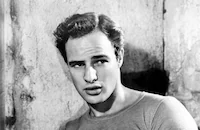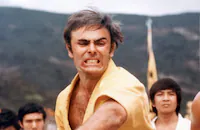The Appaloosa
Brief Synopsis
Cast & Crew
Sidney J. Furie
Marlon Brando
Anjanette Comer
John Saxon
Emilio Fernandez
Alex Montoya
Film Details
Technical Specs

Synopsis
Buffalo hunter Matt Fletcher enters a church in the border town of Ojo Prieto. He plans to begin a new life by using his magnificent Appaloosa stallion to start a horsebreeding farm with his old friend Paco, an impoverished Mexican farmer. His hopes are ruined, however, when Trini, a young woman who has been sold by her parents to Mexican bandit Chuy Medina, tells Chuy that Matt molested her in church. When Chuy enters the church, Trini escapes on Matt's Appaloosa, but she is quickly captured and returned by Chuy's pistoleros. Matt's hopes are shattered when Chuy steals the horse and drags Matt by a rope through a rock-strewn brook. After recovering from his injuries, Matt ventures into Chuy's stronghold and confronts him in a hand-wrestling match in which poisonous scorpions await the one whose arm is forced to the table. Matt loses but saves his life by cutting open the wound with a piece of broken glass. Trini comes to his aid and hides him in a shack owned by Ramos, a goatherd, and nurses him back to health. Squint-Eye, another of Chuy's pistoleros, comes to the shack looking for Matt and Trini, and when Ramos refuses to divulge their whereabouts, Squint-Eye kills Ramos. After killing Squint-Eye, Matt then returns to Chuy's stronghold, retrieves the Appaloosa, and flees toward the border with Trini. Chuy follows, and Matt, realizing that Trini means more to him than the horse, sends out the Appaloosa to draw Chuy's fire. As the bandit aims for the horse, Matt fires and kills him. Matt and Trini then cross the border with the Appaloosa to start a new life.

Director

Sidney J. Furie
Cast

Marlon Brando

Anjanette Comer

John Saxon
Emilio Fernandez
Alex Montoya
Miriam Colon
Rafael Campos

Frank Silvera
Larry D. Mann
Argentina Brunetti
Crew
James Alexander
Salvador Báguez
Carl Beringer
James Bridges
Lyle Cain
Virgil Clark
Peter Colbert
Helen Colvig
Charles Cowie
Poppy Del Vando
Chic Donchin
Hank Edds
Oliver Emert
John Faltis
Robert Forrest
Larry Germain
Joseph Gershenson
William S. Gilmore Jr.
Alexander Golitzen
Douglas Green
William Griffith
Ledger Haddow
Clara Holgate
Ted J. Kent
Roland Kibbee
Olive Koenitz
Norman Mayreis
John Mccarthy Jr.
Ben Mcmahon
Russell Metty
Alan Miller
Edward Muhl
Max Nippell
Bill Nunley
Rosemary Odell
Edwin Pyle
Mark Reedall
Phil Rhodes
Sherrie Rose
Frank Skinner
Bruce Smith
Ken Smith
Alfred Sweeney
David Watson
Waldon O. Watson
Celia Webb
James Welch
Bud Westmore
Wallace Worsley

Film Details
Technical Specs

Quotes
It is a grave I dug for myself. One day when I am tired of living, I will come here for a long visit.- Ramos
The next time you point a gun at me, you better pull that trigger, because I'm going to blow you into so many pieces your friends will get tired of looking for you.- Matt Fletcher
I'm having a little trouble getting started, Father.- Matt Fletcher
You are in the House of God now, my son. Speak from your heart.- Priest
Well, I've done a lot of killin'. I've killed a lot of men and sinned a lot of women. But the men I killed needed killin' and the women wanted sinnin', and well, I never was one much to argue.- Matt Fletcher
Trivia
Notes
Location scenes filmed in St. George, Utah; Lancaster, California; and in the San Bernardino Mountains near Wrightwood, California. The working title of this film is Southwest to Sonora.

Miscellaneous Notes
Released in United States Fall September 15, 1966
Released in United States October 15, 1966
Released in United States on Video May 14, 1996
Techniscope
Released in United States on Video May 14, 1996
Released in United States Fall September 15, 1966
Released in United States October 15, 1966 (New York City)











